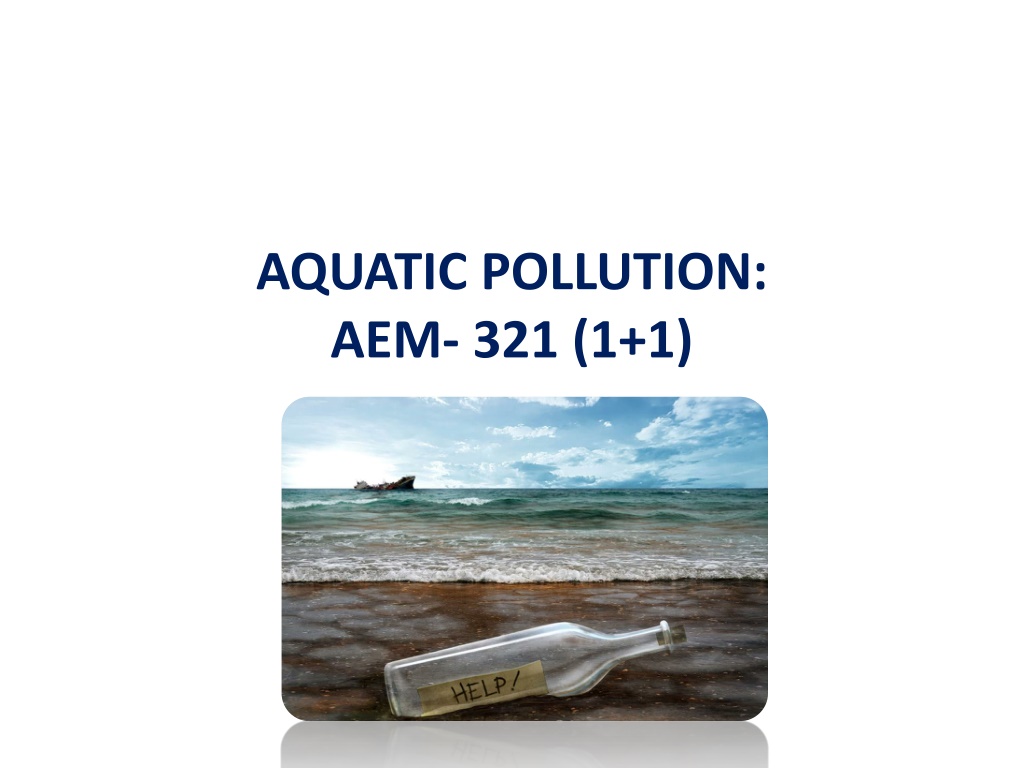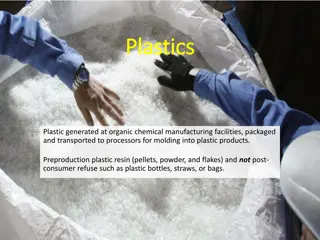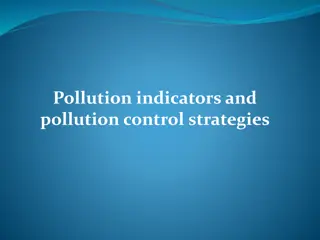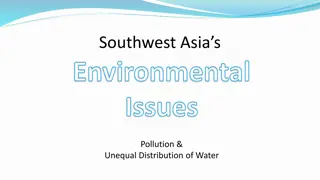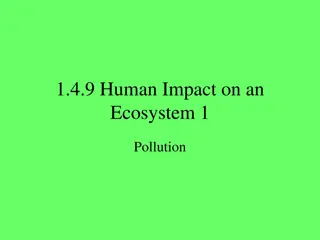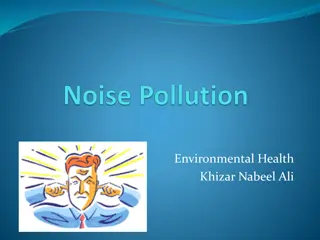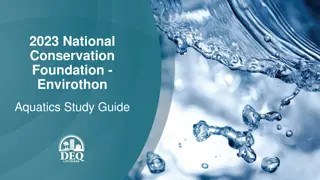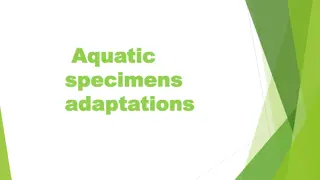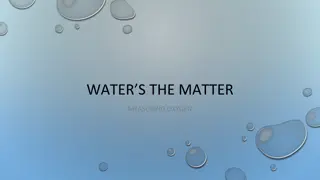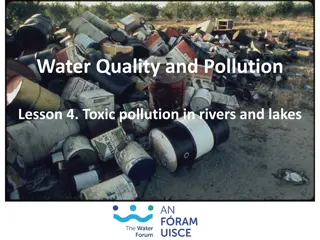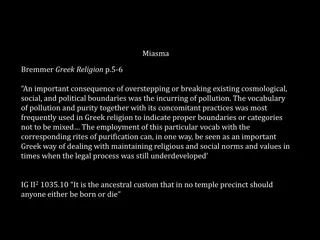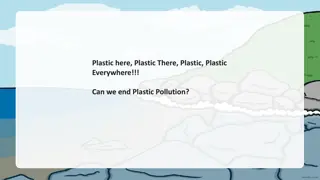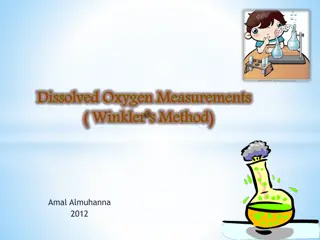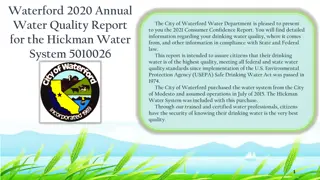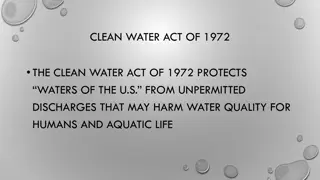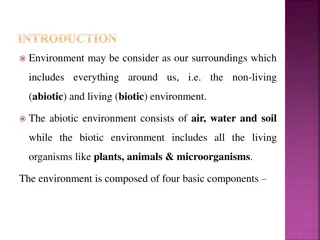Understanding Aquatic Pollution and Its Impact on Water Quality
Aquatic pollution is a significant concern affecting the environment and human health. It includes various pollutants entering water bodies from land-based activities, causing harm to aquatic life and humans. Pollution sources can be classified into point source and non-point source. Monitoring water quality involves assessing physical characteristics such as temperature, color, and odor. Effective pollution control measures are essential to preserve the health of our aquatic ecosystems.
Download Presentation

Please find below an Image/Link to download the presentation.
The content on the website is provided AS IS for your information and personal use only. It may not be sold, licensed, or shared on other websites without obtaining consent from the author. Download presentation by click this link. If you encounter any issues during the download, it is possible that the publisher has removed the file from their server.
E N D
Presentation Transcript
AQUATIC POLLUTION: AEM- 321 (1+1)
Expected learning outcome Definition of pollution, Types of environmental pollution, Classification of pollution Terminologies used Source of pollution and Water quality criteria/standards for inland and coastal waters.
What is Pollution? Pollution is defined as an undesirable change in the physical, chemical or biological characteristics of the environment, which can harmfully affect the health, survival or activities of humans or other living organisms. Why Pollution is Hard to Measure? Natural levels of most contaminants are unknown Pollutant effects can be complex and take a long time to develop Pollutants enter into aquatic environment through a great variety of mechanisms The number of compounds that humans introduce into the ocean is so enormous, it will be difficult to track.
Water Pollution Water pollution is one of the greatest concerns now a days the impact of which on aquatic life and human beings is significant. All land-based activities bring contaminants including oil and sand from roadways, agricultural chemicals from farmland and nutrients and toxic materials from urban and suburban areas. This runoff finds its way into aquatic environment (lakes, streams, rivers and sea). Definition The introduction by man, directly or indirectly, of substances or energy to the aquatic environment resulting in such deleterious effects as Causing harm to living resources and life, Being hazardous to human health, Hindrance to human activities, environmental resources . or The undesirable changes in the condition of water to the point where the potential of the water for a specific use is limited or impaired. Impairment of quality of the
Sources of pollution The loading of contaminants to surface waters, groundwater, sediments and drinking water occurs via two primary routes: (1) point source pollution and (2) non point-source pollution. Point source pollution This originates from discrete sources whose inputs into the aquatic systems can often be defined in a spatially explicit manner. Examples of point-source pollution include industrial effluents (pulp and paper mills, steel plants, food processing plants), municipal sewage treatment plants and combined sewage- storm water overflows, resource extraction (mining) and land disposal sites (landfill sites, industrial impoundments). Non-point source pollution In contrast it originates from poorly defined, diffuse sources that typically occur over broad geographical scales. Examples of non-point source pollution include agricultural runoff (pesticides, pathogens, fertilizers), storm water and urban runoff, and atmospheric deposition (wet and dry deposition of persistent organic pollutants such as polychlorinated biphenyls, mercury).
Classification of aquatic pollution Water quality measurements fall into three broad categories * Physical characteristics: Temperature, colour and odour, suspended solids and turbidity. * Chemical characteristics: Dissolved oxygen, Biological Oxygen Demand, Chemical Oxygen Demand, nutrients, pH, minerals, metals and organic compound. * Biological characteristics: Types and quantities of aquatic organisms (bacteria, algae, plankton species richness, composition, primary production, feacal coliforms)
Physical Pollution of Water Colour change is not harmful unless it is associated with a toxic chemical but it may affect the quality of sunlight that penetrates to a given depth inhibiting plant and animal metabolism. Turbidity in water mainly arises from colloidal matter, fine suspended particles and soil erosion. Generally greater the turbidity, stronger is the sewage and the industrial effluent concentrations and worst are the effects. Odour pollution of water is caused both by chemical agents (like hydrogen sulphide, free chlorine, ammonia, phenols, alcohols, esters, hydrocarbons) and biological agents (such as algae, fungi, microorganisms). The lower the pH, the higher will be the amount of H2S produced and greater will be the odour nuisance.
Recently, the Royal Commission on Sewage Disposal (London) identified the odour from polluted water as follows: Fishy odour due to organic amines Wormy smell probably due to phosphorus compounds Rotten egg or putrid smell due to HS Earthy odour due to humus Foam is produced by soaps, synthetic detergents and untreated organic effluents from paper and pulp industries.
Chemical Pollution of Water The chemical pollution of water causes changes in acidity and alkalinity or pH, dissolved oxygen and other gases in water. It may be caused either by organic pollutants or inorganic pollutants or by both. Organic pollutants can be biodegradable or non-biodegradable. Biodegradable organic pollutants These pollutants include Proteins from domestic sewage slaughterhouses Fats from sewage, soap production, food processing and wool processing Carbohydrates, sugars, starch etc from sewage, textiles mills and paper mills Polymers, resins, coal, oil and various other organic substances found in domestic and industrial wastes and those synthetic compounds which are non-toxic to some microorganisms. waste from canneries and
Non-biodegradable organic pollutants These pollutants are those which persist in the aquatic system for a long time.for example, pesticides, fungicides, bactericides, nematocides, rodenticides, miticides, etc. Through the use of these organic compounds, toxic chemicals ultimately find their way into the nearby water course. Several gases, toxic metals and compounds have been included in inorganic pollutants, because they also degrade water quality seriously. herbicides, insecticides,
Biological pollution of water Bacterial pollution of water is caused by the excretory products of warm blooded mammals including man,wild and domestic animals. Birds of various genera also degrade water. The main pollutants belong to the coliform group and certain subgroups, faecal streptococci and miscellaneous organisms. Biological pollution is also brought about by other bacteria, viruses, algae, diatoms, protozoans, rotifers, crustaceans and plants. Contaminated water supplies frequently create infection of the intestinal tract (like dysentery, cholera, typhoid and gastroenteritis), polio and infectious hepatitis.
Sewage and domestic wastes, treatment and reuse Sewage is defined as waste water/matter from domestic or industrial establishments that is carried away in sewers and drains.
Composition of Sewage Sewage effluents contain a wide variety of dissolved and suspended impurities from municipal/domestic waste, rainwater and anything washed down. Eventhough, the quantity of sewage disposed varies from place to place, the chemical characteristics remain similar. In general, sewage contains dissolved solids, suspended solids, nutrients (N, P), sulphate, chloride and heavy metals (Fe, Cu, Co, Zn, Pb, Ni), bacteria and viruses. Sewage consists of 99% water and 1% solids. Of the solids present in sewage, 70% are organic and 30% are inorganic in nature. The organic fraction contains proteins (60%), carbohydrates (20%) and fats (10%). The inorganic fraction contains grit, salts and metals.
